#ectoParasites
Text
EctoParasites
So what if our cleaner fish blob ghosts friends were not so friendly and instead started being parasites? Danny finally got accepted to college and now blobs are attacking him? He doesn't have time for this. He DOES, however, have time for the cute guy he keeps seeing at the library.
76 notes
·
View notes
Text
picked up a 1953 copy of Fleas, Flukes, and Cuckoos by (Dame) Miriam Rothschild and Theresa Clay today.

I love parasites so of course upon seeing the title, I couldn't say no. The book is focused on parasites affecting birds, of all types, internal, external, brood parasites... invertebrates and vertebrates... I do love to see so many walks of life contained in a single-topic book that isn't just a nature guide.
(You may notice the "R U" contained in the repeating motifs on the cover. This book was a book from the Readers Union, which was basically a subscription service for books)
one of the biggest draws was the plates and figures:
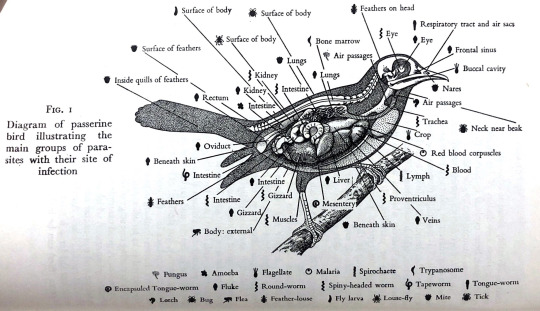
Fig 1: "Diagram of passerine bird illustrating the main groups of parasites with their site of infection."
I love this one, a charming crash-course on both bird anatomy and the diversity of smaller-size parasites the book covers. it covers these in a good level of detail, too.


for example, it gives comparisons of morphological differences one may observe between different modes of parasite life. The plates on the left show the mouthparts of different invertebrates which feed in different ways. The figure on the right shows the attachment organs of different intestinal worms, showing the variety of "anchors" these worms use to avoid being washed out of a host's intestines.
That's quite broad. It goes deeper. For many invertebrate species, the only way to identify one species from another is by observing the shape of its genitals under high magnification... and so they provide:
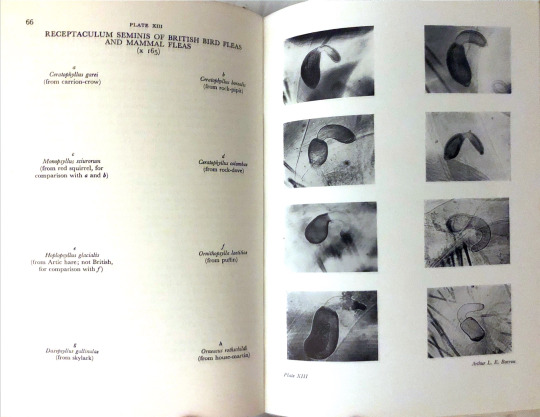
I'll make an effort to go through and snatch up more of these plates and figures, some of them are beautiful.
it is not a purely anatomical text. There is a good amount of discussion of the ecology of parasites, including multi-host life cycles (which are pretty common to see).

Here we have the life cycle of Cryptocotyle lingua, which seems to be lacking in online presence; the second host of inshore fish does make it a parasite of interest to fish farmers, which is apparent when browsing papers on Cryptocotyle flukes. if you know more about these guys, please add on!!
Of course not all parasites are invertebrates. the book has plenty on vertebrate parasites, such as skuas, and of course the beloved cuckoo mentioned in the title.

I quite like the inclusion of the skua here since kleptoparasites need some time in the spotlight. Cuckoos are amazing, they deserve a post of their own.
With old biology books, though, I tend to have reservations about the actual biology facts provided within. some fields of biology, e.g., palaeontology, are so fast moving that something that was the new trendy hypothesis is old within a few weeks. Usually I get these books for the plates, and for the history, namely, the comparison of what the authors knew and what we now know.
The then-now comparison that struck me immediately was in the first paragraph of the preface:
"An object of the New Naturalist series is ... the encouragement of unusual and original developments of [natural history's] forgotten or neglected facets. One such facet is the study of parasites, a study all too long regarded as curiosity about mere curiousness, or as excursions into backwaters. Some popular books that have been written on the subject have stressed the unusual, the mysterious, often the macabre. Few have taken the subject truly seriously."
...I do feel this thinking persists in a lot of circles. Parasites are always weird gross-out animals, or at least, the invertebrate ones are. even people who are animal-lovers or environmentally-conscious tend to be keen to take to the idea of Kill All Ticks, or whatever (this is not the same as not wanting to have ticks on your body). It sucks that this sentiment is so pervasive, but it did also feel like "The Editors" (as they signed the preface) reached across decades of separation to shake my hand and go hey, yeah, that bothers me too! Let's do something about it (write this book).
Oh, and a lot more than write this book, a whole lot more. While Theresa Clay is a subject of scrutiny for her association with a fraudulent scientist, Dame Miriam Rothschild was from a lineage of accomplished parasitologists, as well as being one herself -- one of the most established flea experts of her contemporaries, as well as a lepidopterist with an interest in mimicry. She was a great scientist, and has many other achievements: working at Bletchley Park in WWII with Alan Turing, pressuring the UK govt to accept more German Jewish refugees, personally housing some of said refugees & providing a hospital for wounded soldiers, advocating for gay rights, and funding research into understanding schizophrenia and helping folks w/ it. amazing!!

here she is with her wildflowers, grown at the very same house she housed refugees and treated the wounded. You can order packets of seeds from these wildflowers, proceeds go to research to fight cancer, septic shock, and covid-19. She was a pioneer of wildflower gardens as well, creating the "Farmer's Nightmare" seed mix. yet another gift from her. All of these amazing things amplify the need to read this book in full and more thoroughly record all interesting tidbits.
I wish I could have met her, and asked her about this book, and if there was anything she would add or update, or if there were any fun stories. she seems like a real gem of a scientist and activist.
#miriam rothschild#dame miriam rothschild#jewish scientists#woman scientists#parasites#parasitology#ectoparasites#endoparasites#old books#antique books#biology#zoology#ticks#flukes#fleas#miaow#osedax bookblog
11 notes
·
View notes
Text
What are ectoparasites?
Ectoparasites are ones that affect the outside of a person. They do not attach inside like helminths and mostly attack the skin. Ecto means external, so none of these want to crawl inside of you. However, they are still potential carriers of viruses, so they can carry multiple risks.
When these parasites are present, they are an infestation. For endoparasites, it is an infection as they attack from the inside. These are easier to remove than endoparasites due to them being more noticeable and medications not being necessarily needed.
Examples of ectoparasites:
Most ectoparasites appear as bugs and are small. They aren’t microscopic, but you do have to have somewhat good eyesight to locate where they are. Most mainly affect mammals and humans with a few exceptions. The main exception is leeches though who mainly target fish and reptiles, but occasionally get attached to humans and mammals.
The information covers their lifecycle, how they are transmitted, symptoms, diseases they may carry, and areas they affect.
Bed Bugs
Bed bugs are small, flat parasites that range from one mm to 7 mm. They appear reddish brown, are wingless, and feed off of blood. They range all over the world.
Bed bugs live in areas of sleeping because humans are their main source of food and there is a less likelihood of being killed if they only come out during night when people sleep. They will live in any area with humans through dining rooms, furniture, clothes, hotels, trains, and behind wallpaper. They only tend to stay within 8 feet of their living spaces though. Also, they will feed, then return to their hiding spots unlike other ectoparasites.
They do not arrive because of unclean areas, although unhygienic spaces can make them worse. They also do not typically carry diseases, but can cause allergic reactions. The most they can give you is some itching and annoyance. The way they take blood is through microscopic, saw-like fangs that cut through human skin before they suck up the blood. They produce aesthetic and anti-clotting chemicals in order to minimize the pain from them cutting you to take your blood. This is why you appear so red and itchy after being bitten. The marks take about a week to fully appear, however. They also produce a sweet, but musty smell from the blood they eat.
The entire life cycle of bed bugs takes around 40 days to complete, but their lifespans can be up to 300 days. Bed bugs can starve for around 70 days and be fine, but around that mark they will soon die of dehydration as blood is their only source of food. So, dehydration is the way to kill them. Also, they cannot reproduce unless they have recently fed. A female can lay over 100 eggs in her lifetime and she can mate more than once or only once depending on her resources. They start as microscopic eggs and are about that size until they are close to adults. They need to eat to grow, they do not mature on their own. The males stab the females through her exoskeleton in order to inseminate her. Also, bed bugs molt during their life, so previous exoskeletons may be traceable.
Fleas
Fleas are small insects that feed off of the blood of animals and humans. They can sometimes carry diseases. There are two subtypes and both feed off of humans, but the more common feed off of cats and dogs primarily (Ctenocephalides canis and C. felis). They are found everywhere.
They start as oval eggs that hatch into larvae. Then, they mature into pupae and adults. The larvae stay at that size for around 4 days and feed off of organic debris such as dead skin before covering themselves in the debris to mature into pupae for around a month. They are dormant then. Then, they mature into adults and start seeking for meals from animals or humans. Most do not survive the winter.
They appear with layers of their exoskeleton and are typically black to yellowish in color. They will travel werever to find food, so they will hop from creature to creature to keep eating.
They produce a numbing agent in their mouth in order to limit the pain as they bite you. The chemicals may trigger an allergic response with itchiness. Fleas may also carry tapeworms that infect dogs and children the most.
There are over 2k species of fleas, so all cannot be covered, but a lot can carry diseases such as cat scratch disease and some strains of Typhus. Fleas appear more in unhygienic areas as they blend in easier and they are typically more creatures to feed off of.
Lice/Louse
There are 3 types of lice (Head, body/clothes, and pubic) and all of them feed off of human blood. Only body lice carry diseases like relapsing fever. They only feed on humans, so animals do not play any part in transmission. Lice also cannot fly or hop, they must crawl. They are around 2 mm long.
Lice have hooks to attach themselves to hair (head, pubic, facial, etc. depending on the type). They don’t produce a numbing agent as they are so small, but their bites can carry bacteria and cause irritation. You don’t feel itchy from them biting, but just from them crawling on you.
Their life cycles are in 3 stages; nit/eggs, nymph /larvae, and adult. The nits take 2 weeks to hatch and are almost invisible to the naked eye. They also appear to be dandruff. Nymphs take a week to mature into adults and mature into grayish adults. They also live best at room temperature and don’t survive winters. Their lifespans are only about a week long, but they reproduce at fast rates.
Hygiene is directly related to them being present as daily or minimum week showers are a good prevention. Wearing clean clothes daily also keeps them from latching on as easily.
Ticks
Ticks are insect looking parasites that feed off of the blood of creatures and they are all across North America, but most are in the South. There are 9 different subtypes with all different geography, diseases they carry, and appearance.
Almost all ticks follow the life cycle of being small eggs that hatch immediately, then larve and nymphs (see above). They feast off of blood to keep growing and latch on. Once they find one suitable host, most times they don’t leave until their food source is infected and they latch on by using a mouth claw that digs into the skin, keeping them buried.
Ticks can carry lyme disease, relapsing fever, encephalitis, and other types of fevers. Ticks can give these diseases to humans, rats, dogs, rodents, and other animals. Ticks don’t discriminate.
Leeches
Leeches are worm parasites that have 34 body segments and mostly live in freshwater. They feed off of reptiles and fish species the most, but humans can also get infested by them. Their adult size can be 8-10 inches and they appear gray or black. They are tube-like with sucks on one end to keep them on the host and an open mouth with hypodermic needle-like fangs so they can feed.
They produce chemicals to prevent blood clotting, so a host may bleed more when bitten. This is to make it easier for them to feed. They latch on with their fangs and are somewhat hard to get removed due to latching onto your skin. Their anticoagulant salvia may also have a numbing effect, so you won’t feel them until you see them.
There are many different subspecies, but most North American species go for the outer skin while other ones latch onto the throat and lungs when swallowed. All their life cycles go from eggs to small babies to adults though. Leeches do not seem to transmit disease.
#ectoparasites#parasites#parasite#ticks#fleas#leeches#bed bugs#lice#research#my research#science#external parasites#mad science#mad scientists#mad scientist#wet specimens
6 notes
·
View notes
Text
Fun Parasite fact!
Did you know there are three categories of Parasites that effect humans?
---
Protozoa
Microscopic, these single-celled friends are able to multiple in humans from even just one organism! There are also 4 groups of these fellas based on their movement.
Entamoeba is one such example of a protozoa.
Helminths
Unlike Protozoa, these guys are multicellular, don't reproduce in the body and, as adults, are visible to the naked eye! These Parasites have 3 main groups.
Tapeworms are a well know example of Helminths.
Ectoparasites
Don't let their name fool you! Ectoparasites aren't ghosts but instead are a broad category of Parasites which include blood-sucking arthropods and organisms which attach to the skin.
Mosquitoes and ticks both belong to this category.
---
For more information please visit the CDC's Web page on Parasites: www.cdc.gov/parasites
2 notes
·
View notes
Text
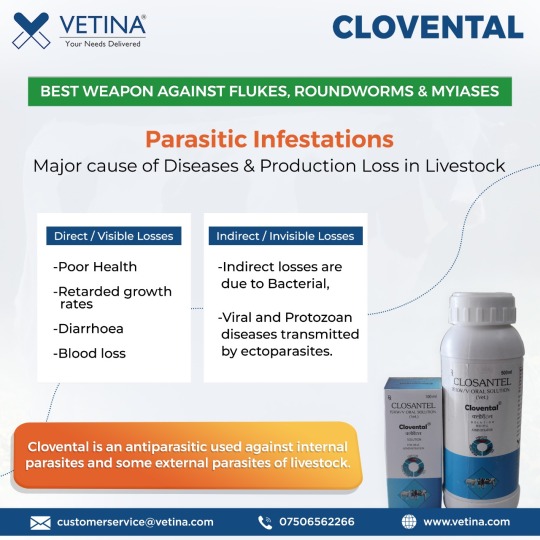
"BEST WEAPON AGAINST FLUKES, ROUNDWORMS & MYIASES"
Parasitic Infestations
Major cause of Diseases & Production Loss in Livestock
#clovental#protozoan#ectoparasites#flukes#roundworms#myiases#Parasiticinfestations#diseases#production#poorhealth#bloodloss#bacterial#visiblelosses#invisiblelosses#medicine#healthy#digestivesystem#cows#pectin#glutamine#puppies#dogs#NaughtyDogs#AnimalHealth#Indianpets#agriculture#Indiadogs#DogsIndia#PetsIndia#vetinacares
0 notes
Text
At this point writing smut would probably be less weird than some of the fic ideas I've been toying with lately
2 notes
·
View notes
Text
What Are the Most Common Veterinary Ectoparasites Found on Pets?
Veterinary ectoparasites are small organisms that live on the outside of animals, like fleas, ticks, and mites. They can cause discomfort and health problems for pets and livestock. These parasites feed on blood or skin, leading to itching, irritation, and sometimes even diseases like Lyme disease or mange. Proper prevention and treatment are crucial to keep animals healthy and happy. Veterinary professionals often recommend regular inspections, grooming, and using appropriate medications to control ectoparasites and protect animals from their harmful effects.
Read more: Veterinary Ectoparasites

0 notes
Text
now time 2 spend the next couple weeks or so second-guessing whether a parasitic worm is categorically worse than the five thousand entomopathic fungus-based skins or not :thumbsup:
0 notes
Text


The archeocete Perucetus colossus dives through a coastal bloom of jellyfish in the Pisco Basin (southern Peru), some time during the Eocene (with bonus multiview).
I originally intended to add epibionts to this reconstruction (reflecting the specialized communities found on many living whales, especially baleen whales). Yet, interestingly, it appears that most animal epibionts and ectoparasites of modern cetaceans, such as whale barnacles (Hayashi et al. 2013) and remoras (Friedman et al. 2013), only appeared in the Neogene or late Paleogene, or have a poorly known (co-)evolutionary history, like whale lice (Pfeiffer 2009, Iwasa-Arai & Serejo 2018) and pennellids (large parasitic copepods) (Hermosilla et al. 2015). So, no epibionts* for big lad Perucetus!
References and notes about the reconstruction:
*animal epibionts. Unicellular eukaryotes like diatoms were most likely present on early cetaceans, given their prevalence on modern large marine animals (Ashworth et al. 2022). Of course, it is possible that other animals (i.e., early, less specialized representatives of modern groups, or different taxa altogether) were also already exploiting the surfaces offered by these early whales; however, this remains entirely speculative.
The reconstruction of Perucetus proposed in its original description (Bianucci et al. 2023) includes some rather odd (if interesting) choices about soft tissues, including limbs with webbed and distinguishable fingers, and a manatee-like tail. While these choices might be defendable in light of the rather basal status of Perucetus among cetaceans, I opted for a more derived look based on the assumption that fully marine cetaceans like basilosaurids would have probably rapidly acquired hydrodynamically favorable adaptations, pushing them towards a more familiar Neoceti-like appearance (even though Perucetus itself was likely a poor swimmer (Bianucci et al. 2023), it seems likely to me that this was a secondarily acquired trait, given the less extreme morphology of other basilosaurids).
Reconstruction in the multiview scaled to ~18 m in length after the estimations of Bianucci et al. (2023).
References:
Ashworth, M. P., Majewska, R., Frankovich, T. A., Sullivan, M., Bosak, S., Filek, K., Van de Vijver, B., Arendt, M., Schwenter, J., Nel, R., Robinson, N. J., Gary, M. P., Theriot, E. C., Stacy, N. I., Lam, D. W., Perrault, J. R., Manire, C. A., & Manning, S. R. (2022). Cultivating epizoic diatoms provides insights into the evolution and ecology of both epibionts and hosts. Scientific Reports, 12(1), Article 1. https://doi.org/10.1038/s41598-022-19064-0
Bianucci, G., Lambert, O., Urbina, M., Merella, M., Collareta, A., Bennion, R., Salas-Gismondi, R., Benites-Palomino, A., Post, K., de Muizon, C., Bosio, G., Di Celma, C., Malinverno, E., Pierantoni, P. P., Villa, I. M., & Amson, E. (2023). A heavyweight early whale pushes the boundaries of vertebrate morphology. Nature, 620(7975), Article 7975. https://doi.org/10.1038/s41586-023-06381-1
Friedman, M., Johanson, Z., Harrington, R. C., Near, T. J., & Graham, M. R. (2013). An early fossil remora (Echeneoidea) reveals the evolutionary assembly of the adhesion disc. Proceedings of the Royal Society B: Biological Sciences, 280(1766), 20131200. https://doi.org/10.1098/rspb.2013.1200
Hayashi, R., Chan, B. K. K., Simon-Blecher, N., Watanabe, H., Guy-Haim, T., Yonezawa, T., Levy, Y., Shuto, T., & Achituv, Y. (2013). Phylogenetic position and evolutionary history of the turtle and whale barnacles (Cirripedia: Balanomorpha: Coronuloidea). Molecular Phylogenetics and Evolution, 67(1), 9–14. https://doi.org/10.1016/j.ympev.2012.12.018
Hermosilla, C., Silva, L. M. R., Prieto, R., Kleinertz, S., Taubert, A., & Silva, M. A. (2015). Endo- and ectoparasites of large whales (Cetartiodactyla: Balaenopteridae, Physeteridae): Overcoming difficulties in obtaining appropriate samples by non- and minimally-invasive methods. International Journal for Parasitology: Parasites and Wildlife, 4(3), 414–420. https://doi.org/10.1016/j.ijppaw.2015.11.002
Pfeiffer, C. J. (2009). Whale Lice. In W. F. Perrin, B. Würsig, & J. G. M. Thewissen (Eds.), Encyclopedia of Marine Mammals (Second Edition) (pp. 1220–1223). Academic Press. https://doi.org/10.1016/B978-0-12-373553-9.00279-0
#'a heavyweight early whale pushes the boundaries of...' blablabla you've all read it by now#i have nothing to add#it's fat#look at it#that is all#perucetus#cetacean#mammal#vertebrate#eocene#cenozoic#paleontology#palaeoblr#paleoart#my art
399 notes
·
View notes
Text
I love lice I’m sorry that everyone is mean to you it’s not your fault you’re an obligate ectoparasite and disease vector
#els.txt#very passionate about parasites this evening#posts made by a British soldier in the French trenches in wwi
301 notes
·
View notes
Text
EctoParasites - Acceptance
I've started a new fic and posted a little blurb and got a decent response so I'm going to start posting unedited chapters/scenes. Hoping that the sweet sweet dopamine will also motivate me to KEEP writing. So here's some good-mom Maddie Fenton and her sweet obsessed Ghost son.
Gotham U Acceptance Letter
“Mom! I got accepted! I got the scholarship! With a full ride! They loved my submission. remember the competition they ran for the ISS for experiment submissions and I told you all about the way that the Zone acts a lot like the minimal gravity of space and how that really messed with my proprioception when I first started spending long spans of time in the zone and then coming back? So I thought that maybe it might be an issue for the astronauts too! So I submitted that thought, but you know, leaving out the stuff about the Zone because that’s not really common knowledge, I just reframed it as a hypothetical situation, so I proposed some exercises that the astronauts could do on earth, and then - Are you listening mom?”
Maddie nodded as she continued recalibrating an ecto-gun to be a little more non-lethal. “Yes, dear. I remember you telling me all about it. What did the Wayne Enterprises Scholarship board say about the idea?” She looked up from the blaster briefly to see that Danny was pacing back and forth about 4 inches off the ground. Even though they now knew about his powers, Danny still defaulted to trying to hide his powers. He just….got worse at it. Being able to unmask had made a huge difference in his mental health but the mask couldn’t quite be put all the way back on anymore.
“Oh yeah. I couldn’t remember if i’d told you. But yeah! They loved it. I actually got a response letter from one of the Canadian astronauts. Chris Hadfield? He's done a lot of the elementary school kids’ experiments and he usually films them and uploads them to ViewTube. His channel is super popular. Him. I got a letter from Hadfield that is was really well thought out experiment and he’s going to personally do it along with a couple others who are scheduled to go up on the next trip, I’m gunna frame that letter. It’s going on my wall forever. He didn’t say when that was.” Danny had continued his pacing around the lab. He had been just phasing through the tables in his excitement but after knocking over phase proof equipment about 7 times, he was now pacing above the tables. “and. um… Oh yeah, the scholarship! They loved it and the scholarship board is going to send over the enrollment paperwork for Gotham U and then all the stipulations and conditions of the scholarship. I’ve gotta keep at least a 3.2 average or I’ll lose my scholarship and-”
Danny’s voice went quieter as he started mumbling to himself and Maddie just shook her head. She’d reel him back in before dinner time but for now he was just happily spiraling, both mentally and physically near the ceiling.
#dpxdc#EctoParasites#my writing#Good parents AU#No vivisection#why is that tag even needed#reveal gone right#Danny living his best space dreams#if you see a typo#no you didn't
32 notes
·
View notes
Text
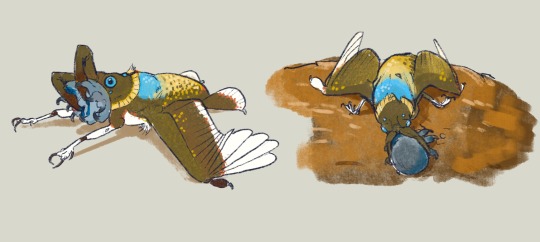
A small “bird” that preys on parasites. This species is not normally a threat to birg larvae, which are sheltered underground while they are small. It is but one of many avian predators that specializes in hunting ectoparasites.
—————
Kofi
Inprnt
583 notes
·
View notes
Text
Remoras

If you've ever observed sharks, you may have seen an image similar to today's shark photo: a shark tailed by some fish seemingly unbothered by the large predator they're following. These fish belong to a group of fish called the remoras or suckerfish.
Remoras got the name 'suckerfish' due to their ability to attach themselves to the side of an animal. To do this, they have a uniquely modified dorsal fin, flattened to form a series of disk lamellae which can create a vacuum to suction the fish to a host animal. Remoras attach themselves to many types of megafauna, including whales, dolphins and, of course, sharks.
The main benefit the remoras get from this adaptation is the ability to migrate large distances while attached with very little energy costs. In addition, the remoras get some protection from predators by shadowing large animals (what predator wants to risk messing with a shark, after all).

The nature of the relationship between remoras and megafauna is still debated. The most widely accepted opinion is that the relationship is commensal (the remoras benefit from the relationship while the host animal neither benefits nor is harmed by it), with observed sharks generally being unbothered by the remora's presence (as they tend to be by most things).
However, remoras have been observed grazing on harmful ectoparasites on the skin of whale sharks and ectoparasites have been discovered in the stomachs of remoras, suggesting the relationship may actually be symbiotic (both the remoras and the host animal benefits from the relationship).
On the other hand, the added weight from the attached remoras may create more drag on the host animal which may not affect large whales and sharks but smaller megafauna may face greater travelling costs from it. Additionally, dolphins have been observed spinning out of the water with remoras attached, theorised to be a method of the dolphins shaking the remoras off itself, suggesting the relationship may be parasitic (the remoras benefit from the relationship while the host animal is harmed by it).
109 notes
·
View notes
Text

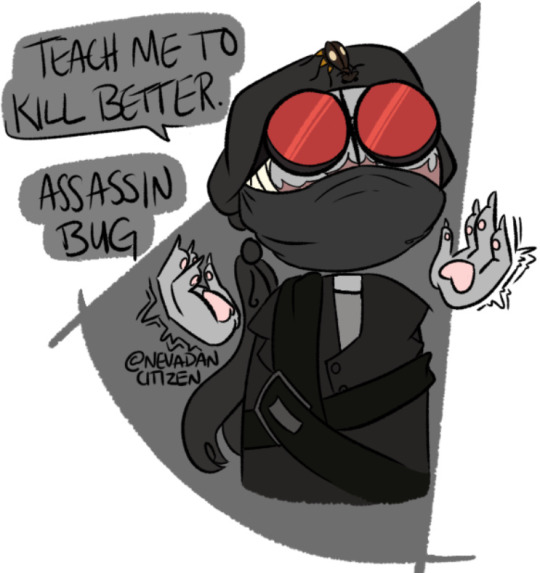
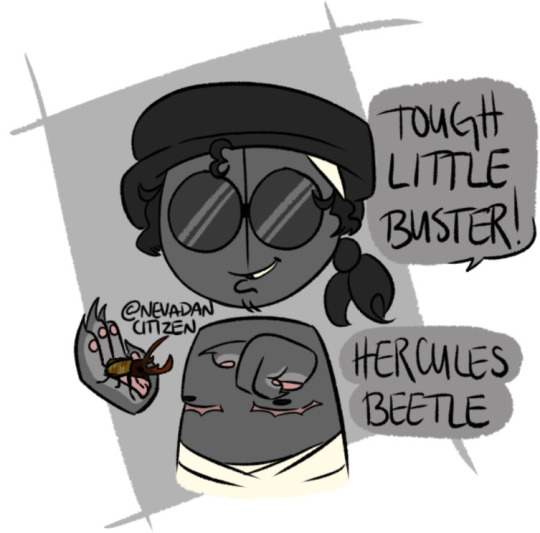

moved house recently and the movers literally destroyed my insect display case and the specimens inside so i drew the sillies with the insects i think would represent them best to soothe the pain. explanation below the cut (be warned, it’s long and so so fucking nerdy)
(+ sanford bombardier beetle follow-up)
okay so first is doc with a madagascar hissing cockroach. despite cultural connotations, cockroaches are some of the smartest insects (up there with bees, wasps, and termites (which they share an order with — blattodea)), and doc is nothing if not the brains of SQ. madagascar hissing cockroaches are some of the few insects that stay with their offspring for a long while, therefore protecting them. doc is also protective of his men in a somewhat similar fashion, albeit from a distance and behind a cold, stern demeanor. also these roaches can’t fly, and doc can’t drive. there’s a joke in there somewhere but i can’t find it.
then we’ve got hank with an assassin bug. there’s not really any notable species within the family, so it’s just supposed to be a general insect within reduviidae (but not an ectoparasite). some assassin bugs transmit chagas disease, which is mostly always unwanted and detrimental, much like hank’s presence to anyone outside of SQ (or within the SQ, because hank’s loyalty mostly just faults to his own bloodlust). assassin bugs also have one of the most painful insect bites but, unlike hank, they use chemicals (injected via proboscis) to induce pain rather than ripping and tearing. still, the end result is the same.
obviously, what else would sanford have other than a hercules beetle? they’re one of the strongest insects (as evidenced by the horns on their head and prothorax), and sanford is, unarguably, the strongest grunt of the SQ. male hercules beetles use their horns to grapple and fight (both for territory and mates), and sanford also uses very melee-heavy tactics while fighting. they also use their horns to leverage and throw their opponents, and sanford uses his hook with similar tactics. these beetles are very hardy (due to their exoskeleton and hardened elytra) just like sanford, despite his usual lack of clothing and armor.
lastly, there’s deimos and the australian tiger beetle. they’re known as the fastest species of tiger beetle (up to 9 km/h or 5.6 mph) and — not sure if this is canon or a universally accepted headcanon — deimos is the fastest grunt of the SQ. these beetles run so fast and hunt so aggressively that their sensory system literally can’t keep up and their eyes shut off, so they have to stop often (for just a fraction of a second) to regain their faculties, which gives their prey several chances to escape. this reflects in deimos through his jokey demeanor and tendency to not take things seriously until it’s too late. thankfully, the australian tiger beetle is only listed as “near threatened” on the red list, unlike deimos, who is totally fucking dead.
thank you for coming to my ted talk which is just me smushing my two special interests together like a child mixing play-doh
#riptide’s drawings ✏️#madness combat 🆘#also peek at doc’s filed-down claws i really like that little detail#madcom#madness combat#madness combat deimos#madness combat sanford#madness combat hank#madness combat 2bdamned#madness combat doc#deimos#sanford#hank j wimbleton#2bdamned#madcom deimos#madcom sanford#madcom hank#madcom 2bdamned#madcom doc#madness: project nexus#project nexus
95 notes
·
View notes
Note
While the hosts as spaceships thing is cool I've always been fascinated by parasites (and other things that live in and on animals since some are beneficial or benign, like gut bacteria and those eyelash mites [though those might technically be parasites? I'm not clear what makes the difference between a harmless parasite and a Guy Who Just Lives On You]) because they make one recontextualize animals as environments and ecosystems in their own right. You are an ecosystem, your dog is an ecosystem, every person and animal you meet is an ecosystem, there are other animals that can and will and sometimes do view you as a hospitable, just right place to live, it amazes me, I am like a desert, plain, or forest, there are creatures that would choose no other place to live than me (which is unfortunate with harmful parasites but AMAZING with the benign/beneficial things that reside on a body, like wow those things wouldn't want to be anywhere else, how nice for both of us)
Yep the majority of life on Earth in terms of total species as well as population numbers is symbiotic in or on other living thing's bodies, and parasitism is the most common form of symbiosis! So mainly we're a planet of very very tiny creatures who mostly have to live inside the mighty titan monsters who can magically live in just the dirt and water.
Beneficial body friends are called mutual symbiotes and what they do is mutualism or mutual symbiosis, while sneaky ones that eat you are doing parasitic symbiosis, and guys who are just there for the ride and don't make a big difference are commensal symbiotes.
But the lines ARE blurry to the point that for a lot of species we can't even make a meaningful distinction at all. There are some things that feed on their host for instance but they're so small in comparison they don't cause any noticeable harm, so does that make them commensal? How do we decide the cut-off point? Sometimes a commensal creature does feed on something from the host, but it's not something the host usually needs, UNLESS the commensals become overpopulated. For instance, mites that usually eat harmless amounts of extra skin oil can sometimes boom in number until they're taking *too much* skin oil, causing psoriasis! Did they "become" parasitic, then?!
Lice are considered ectoparasitic (external parasites) because they breed directly on the host's body and feed on blood. But fleas come and go from their host, raising their young in the surrounding environment, so are they true parasites? Vampire bats and mosquitoes drink blood but they never spend any time living ON another animal, so some in biology have started calling those "micropredators" instead of parasites.
It gets extra confusing with "parasitoids," like wasps. We think of a parasite as something that feeds on another animal long-term, without killing it, but parasitic wasp larvae have to kill the host to mature, and that's why they get called "parasitoid" or "parasite-like," which isn't considered a really technical distinction. Maybe we should think of them as a predator, but the adult wasp doesn't *eat* the host, the "parasitic" larva just consumes enough of the host to finally kill it. How slowly does something have to kill its prey to be a predator vs. a parasitoid vs. a true parasite?! Nobody can agree!
296 notes
·
View notes
Text
🐠 Daily Fish Fact: 🐠
*Finding Nemo Series #9*
Royal Gramma: Their natural range covers the Bahamas, Venezuela, Antilles, Bermuda, and through the waters surrounding Central America and the northern part of South America. They are also cleaner fish. They remove the ectoparasites from other fish and learns to eat dead food, such as crustaceans and fish flesh.


#royal gramma#purple#yellow#cleaner fish#aquarium fish#finding nemo#finding nemo series#finding nemo fish facts#fish of finding nemo#finding nemo fish#fish#daily fish fact#facts about fish#daily fish#fish fact#ocean#ocean fish#ocean life#marine#marine life#marine fish#marine biology#special interest#fish of fhe world
77 notes
·
View notes